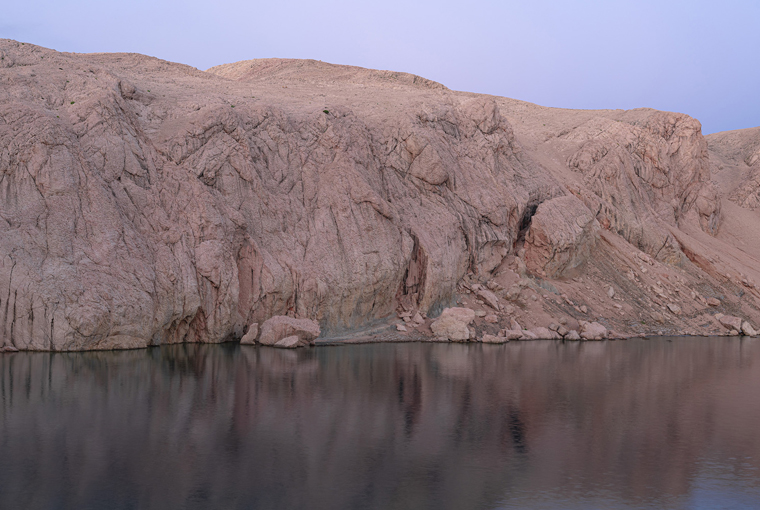The Dialectical Image
Davor Konjikušić and Nika Petković’s Uvala (2021)
Vol. 122 (February 2022) by Anna Doyle
Uvala” is a word used in the Balkan region to denote closed depressions in karst areas. In the eponymous film by Davor Konjikušić and Nika Petković, the cove of Slana is filmed with techniques of landscape cinematography that explore the sandy valley from different points of view and angles. The absence of human beings in the images instills a deliberate “ennui” in the viewer. Yet, knowledge of what the cove of Slana represents historically reveals it to be a place of memory and former human presence. Through archival research and 3D modelling, the filmmakers try to turn Slana into a space of commemoration, thereby challenging repeated attempts to erase its memory. Meanwhile, we, the viewers, who are in many cases oblivious to its history, are to a certain extent complicit in its erasure from collective memory.
Emptiness seems intrinsic to the desertic landscape we are introduced to. The filmmakers use no dialog or voice-over in presenting it. However, a pervasive underlying tension attaches to this settled absence and silence. What can only be gathered from the film description is that this emptiness is intertwined with grazing, deforestation, recent tourist exploitation and, crucially for the film, the establishment of a concentration camp during WWII. Since 1983, the cove of Slana is officially acknowledged to be a place of remembrance. But attempts to keep alive the memory of this place have been squashed by exploits and destruction. The memory plaque dedicated to the victims of the camp was destroyed by unidentified perpetrators on two separate occasions, in both cases after a commemoration ceremony. The film reflects on this symbolic erasure of memory.
Located on the island of Pag, Slana was the place of the first concentration camp on the territory of the Independent State of Croatia. In the summer of 1941, the camp was constructed in Metajna, which was controlled by the Ustaše, the ultranationalists who aligned themselves with Hitler and Mussolini during WWII. Camp conditions were such that the Italian military closed it down in August 1941, fearing local rebellion. Though the film does not detail death counts or the horrors perpetrated there, between 4,000 and 12,000 men and women died in the camp, among them Jews, Serbs, and Croatian Communists. Especially in the first weeks, many died as a result of physical abuse, exhaustion, heat, hunger, and thirst. As the camp became overpopulated, its administrations increasingly resorted to executions. Perhaps it is also the impossibility of depicting such atrocities that pushed the filmmakers to show the place as vacant. From our contemporary point of view, the place can seem rather beautiful – which is a point of view the film seeks to pervert. This is so even though nothing in the film seems to point to the pitfalls of human remembrance or the deliberate erasure that has been taking place here. Nor does the untouched self-sufficiency of the landscape reflects its tourist exploitation. 3D images at the end of the film feature a digital reconstruction of the camp – as if wanting to create an X-ray of the landscape that uncovers what lies beneath the unseeming valleys. Even with this final summoning of the death architecture of the place, the film evokes atrocity through minimalism and absence, thereby taking another direction than previous studies of the place such as Croatian writer Ante Zemljar’s Charon and Destinies, who gave a vivid and detailed depiction of the camps of Slana in 1988.
The pitfalls of representing history explored in this film call to mind Harun Farocki’s Images of the World and the Inscription of War (1989). Farocki’s film concentrates on the overlooked traces of aerial photographs taken during an American bombing raid of an industrial plant in Germany during WWII. An analysis of the documents 33 years on revealed that the Auschwitz concentration camp had been captured in these images, but overlooked because their purpose was to identify specific military targets. Farocki draws a link between knowing and seeing, reminding us that even photographic documents can be interpreted in the wrong way because people are conditioned by what they want to see. In both films, photography and/or cinematography seems objective. In fact, they belie an underlying reality that can only be seen with the right mindset. The truth is hardest to grasp when the evidence is right before your eyes. The images of Uvala can be called what Walter Benjamin called “dialectical images”:1
The historical mark of the images does not indicate only that they belong to a determined epoch, it indicates especially that they reach the legibility only in a determined epoch. […] Each present is determined by the images that are synchronous with it; each Now is the Now of a determined knowability. With it, the truth is charged with time until it explodes. […] The image that is read – I mean the image in the Now of the knowability – carries to the highest degree the mark of the critical moment, perilous, which is at the bottom of any reading.
The images of Uvala stand in a dialectical relationship between the past and the present. If these images bear a secret which is a secret of the past, they also communicate the difficulty of looking at them in the present day. Uvala raises the question how one can move from merely looking at an image to seeing and ultimately reading it. It does so by connecting two synchronous views of a single image: the ignorant view from today, and the painfully revealing act of seeing beyond the “now”.
References
- 1.Benjamin, Walter. Paris, capitale du XIXème siècle – Le Livre des Passages, Ed: Cerf, 2006 [Translation by Author].




Leave a Comment